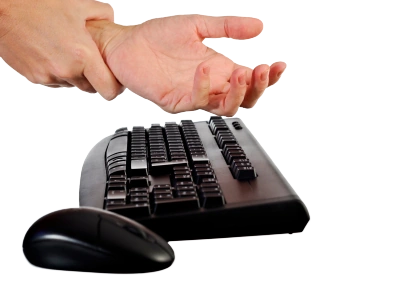
Repetitive Strain Injury
Repetitive Strain Injury (RSI) is a pain syndrome affecting millions of people world-wide and is the number one occupational hazard in the entire US. Most medical practitioners view RSI as a broad syndrome that encapsulates a variety of musculoskeletal disorders affecting the muscles, tendons and nerves in the hands, arms and upper back. According to this view when these muscles are kept tense for unusually long periods of time, due to poor posture or repetitive motions, RSI begins to develop.
The most common types of disorders which can develop are:
-
Carpal tunnel syndrome
(CTS) occurs when the median nerve is compressed at the wrist by the surrounding tendons. Symptoms like tingling, pain, coldness, and sometimes weakness in parts of the hand indicate CTS. It is the most common type of disorder diagnosed by doctors.
-
Tendonitis
is the inflammation of the tendons.
-
Tenosynovitis is the inflammation of the fluid-filled sheath surrounding a tendon (the synovium). It frequently causes tendonitis and is closely related to stenosing tenosynovitis.
-
DeQuervain's Syndrome is an inflammation of the fluid-filled sheath or carpal tunnel that surrounds the two tendons which control the movement of the thumb. This is often caused by the thumbs repetitive up-down motion required by typists to operate a keyboard. Pain and swelling over the thumb side of the wrist, difficulty gripping and numbness on the back of the thumb are the usual symptoms of this disorder.
-
Thoracic outlet syndrome (TOS) consists of a group of distinct disorders that affect the nerves in the brachial plexus (nerves that pass into the arms from the neck) and various nerves and blood vessels between the base of the neck and armpit. For the most part, these disorders have very little in common except the site of occurrence. The disorders are complex, somewhat confusing, and poorly defined, each with various signs and symptoms of the upper limb.
-
Trigger finger/thumb
is a type of stenosing tenosynovitis in which the sheath around a tendon in a thumb or finger becomes swollen and restricts the tendon's movement. Affected joints may become painful to straighten once bent, and may make a soft crackling sound when moved.
-
Intersection Syndrome is a painful condition that affects the thumb side of the forearm where two muscles cross over, or intersect, two underlying wrist tendons. Intersection Syndrome is often confused with DeQuervain's syndrome.
-
Reflex sympathetic dystrophy syndrome (RSDS) also known as complex regional pain syndrome — is a chronic condition characterized by severe burning pain, pathological changes in bone and skin, excessive sweating, tissue swelling, and extreme sensitivity to touch. RSDS is currently classified as a variant of causalgia, not necessarily caused by trauma.
-
Finger arthritis
refers to the inflammation and degeneration of the joints in the fingers, which can cause pain, stiffness, and reduced range of motion. Repetitive strain injury, which occurs as a result of repetitive and prolonged movements, can contribute to the development or worsening of finger arthritis.
After diagnosis of the underlying musculoskeletal disorder, trained physicians usually prescribe the therapies designed for those specific disorders. In many cases these solutions just don't work.
Health Links

